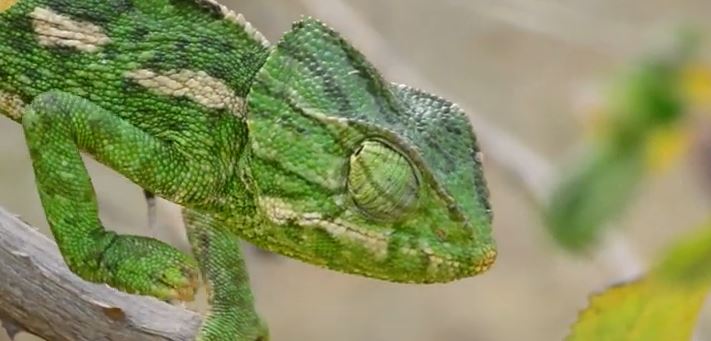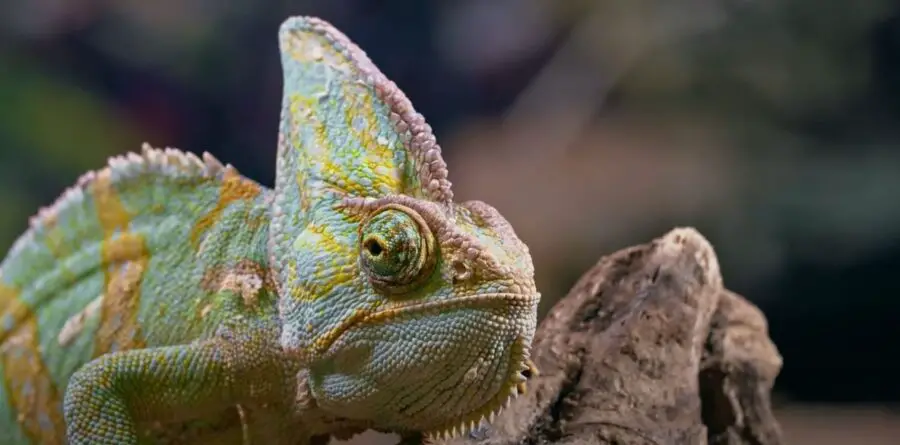To me, it looks like salt stains. White spots on my chameleon made me worry at first until I found out the fact that I wish to explain to you today.
White spots are not related to black spots on a chameleon. Hopefully these white spots are not clustered or raised. Find out why below.
This article is dedicated to discussing white spots on chameleons and for us to assist them if necessary.
White Spots on Chameleon
If you notice white blotches, spots or whiteness around the body of your chameleon, do not be concerned. You can also attribute it to snalt out of a chameleon’s nose and remnants of white spots scattered around their face or front half of their bodies.
In many cases the white spots you are seeing are part of the process where your chameleon is about the shed skin in these areas. Once the shedding phase has completed itself, the white spots on your chameleon will no longer be there.
Humidity, health , diet, supplements, temperature maintenance, low stress and overall comfort in your home’s enclosure for your chameleon will determine the ease of shedding this skin with white spots and throughout.
If the spots are raised bumps or in clusters, it could be a papilloma virus. Allow me to explain in this article below.

What Is Snalt On a Chameleon?
Snalt on a reptile is the white residue that you may commonly see in areas around the nose of a chameleon. Since chameleons are not sweating, the gland located around their nose is able to get rid of salt that accumulates within this location.
A white substance is what comes out and it may look like your chameleon has white spots. Thankfully they are easily removed or with a humid enclosure, the salt will dissipate or even evaporate off your chameleon’s face.
You do not need to mist your chameleon directly to get rid of snalt, but you can mist the general area they are occupying to increase the humidity. Bicarbonate and chloride are expelled and your chameleon is caused by this.
Snalt can form more rapidly if you are misting with hard water in tap water. The white crusty spots are usually centered around the nose and chameleons nails cannot pick it off. If you wish to reduce the occurrence of snalt, choose a different water source when misting.

Chameleon Papilloma
There are cases of wart-like growths on a chameleon that protrude out and are pale or white in color. This could be due to a papilloma virus that is infectious.
Notice how big these white spots are ranging from 2 mm to 20 mm in length. The spot could be round or shaped like horns, You may see these warts in the three main areas on a chameleon:
- Head
- Neck
- Mouth
Look for more indications that this is truly a virus and not peeling white spots due to shedding before you visit the vet. Handle with care and do not make direct contact with your chameleon. The enclosure will have to be cleaned as well if this is papilloma.
How Does A Chameleon Get Papilloma?
Lizards, chameleons and other reptiles may get infected with papilloma during their growth at a breeder’s, under your captivity and much less frequently in the wild.
The causes of contracting papilloma or warts on a chameleon and other reptile companions we care for could have come from the following:
- Bitten by another counterpart of the same species
- Using the same bowls
- Sharing the same enclosure
- Scratched by an infected reptile
- Direct contact with open warts from another chameleon or reptile
- Transferred from a pet owner
Warts could transfer from owner to pet. If a caregiver or breeder has made direct contact with another lizard or chameleon with papilloma and touched another, he or she could have transferred it to them as well.
Symptoms of Papilloma On Reptiles
If your chameleon or other reptile companions have the papilloma virus, this infection could lead to other symptoms that you may notice. Look out for the following:
- Discolored skin
- Lethargy
- Weight loss
- Scratching
- Bleeding
- Warts in the mouth

White Chameleons Skin
A chameleon that is white is probably shedding. A complete loss of pigmentation is not normal and could indicate illness. This is not the case with white spots.
You are probably seeing the drying of the skin in some areas more than others that look like white patches. These spots will get more flaky and peel off. The rest of the dry skin may catch up and form a solid piece that will be easier to remove in one shot.
Your chameleon may rub these white spots more often on surfaces such as branches set up in the enclosure to assist in shedding. Helping a chameleon to remove white spots by pulling or peeling them is not recommended because you can damage the skin around or underneath.
Raise humidity levels slightly or mist the enclosure. The white spots remain for a few days or longer and if they are indeed stuck, you can try to use a damp cotton swab or Q-tip to dab the area. If the white spots are stubborn and not fall off, leave them alone for another day or two.

Dehydrated Chameleon With White Spots
If the skin on a chameleon is sagging, they may also become pale. If this chameleon was undergoing shedding of their skin at the same time as the dehydration was in effect, the white spots would remain stubborn and hard to peel off.
Chameleons need moisture and will have a difficult time shedding when dehydrated. Look for more dehydration symptoms such as:
- Sunken eyes
- Yellow or orange urate
- Lethargy
- Lack of appetite
Final Thoughts
Make sure your chameleon’s environment is well set up with the correct temperature, humidity and fresh, clean water. This goes a long way to assist or prevent dehydration to make their shedding process go smoothly without white spots developing or stuck skin.
Thank you for visiting PocketPetCentral.com for the best information to help you enjoy the life of your pocket pet companion in a fun, safe & healthy way.


